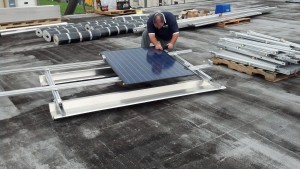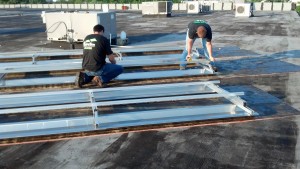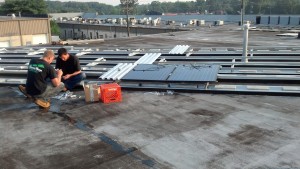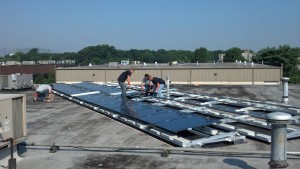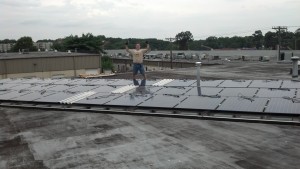Industry and Company News
GreenTech Tests Green Tech(nology)
Posted August 8th, 2013 by GreenTech Energy Services
In an effort to “green” its own building and provide a test site for an innovative renewable energy system, GreenTech Energy Services applied for and was awarded a grant from the PSE&G Technology Demonstration Program. The resulting project, several years in the making, is finally nearing completion.
GreenTech designed and installed a renewable environmental system that reduces air conditioning load by removing humidity non-mechanically. This technology was interfaced with a hybrid solar system that produces PV and thermal heat all in one.
The centerpiece of the project is an HVAC system that lowers energy costs by more than 40% compared to standard HVAC systems. It does this by using a liquid desiccant membrane to remove the humidity from incoming air and discharge it to the outdoors. (It takes less than half the amount of energy to cool air that has been dehumidified.) In addition to cutting energy usage and creating a dryer, more comfortable environment, the system also eliminates 95% of airborne microorganisms.
Integrated into this HVAC system is a rooftop hybrid solar module that combines the functions of both a thermal solar collector and PV module. This provides the facility with most if not all of its electrical needs as well as heat, thereby making the HVAC system even more energy efficient.
At this point, the solar panels have been installed and the ductwork for the HVAC system has been built. Now all we have to do is hook everything together – wiring, plumbing, interconnections, etc.. The photos above show our progress so far.
Summer Fun!
Posted July 23rd, 2013 by GreenTech Energy Services

 In between lighting retrofit projects, GreenTech employees are managing to squeeze in a little fun in the sun this summer. Above is our staff on a fishing expedition off the coast of New Jersey, where they actually managed to catch enough food for dinner. GreenTech is also supporting a number of fundraisers this season, contributing to the American Cancer Society Bike-a-Thon as well as the Multiple Sclerosis Shore Ride. Both rides take cyclists through the small towns and back roads of southern New Jersey, both raise tremendous amounts of money for worthwhile causes, and both provide plenty of exercise for the GreenTech employees who participate.
In between lighting retrofit projects, GreenTech employees are managing to squeeze in a little fun in the sun this summer. Above is our staff on a fishing expedition off the coast of New Jersey, where they actually managed to catch enough food for dinner. GreenTech is also supporting a number of fundraisers this season, contributing to the American Cancer Society Bike-a-Thon as well as the Multiple Sclerosis Shore Ride. Both rides take cyclists through the small towns and back roads of southern New Jersey, both raise tremendous amounts of money for worthwhile causes, and both provide plenty of exercise for the GreenTech employees who participate.
Get Your Lights Under Control!
Posted June 12th, 2013 by GreenTech Energy Services
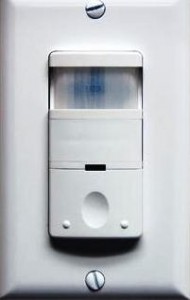 Controls are an essential part of every lighting system. They can be categorized in various ways – dimming or switching, manual or automatic, occupancy or daylight harvesting. But all are designed to save as much energy as possible while still providing appropriate light levels.
Controls are an essential part of every lighting system. They can be categorized in various ways – dimming or switching, manual or automatic, occupancy or daylight harvesting. But all are designed to save as much energy as possible while still providing appropriate light levels.
ON-AND-OFF, OR A LITTLE OF BOTH
- Switching systems are used to turn lighting on and off by connecting or removing lighting sources from the power supply. This type of system is simple, cost-effective, and useful in areas where an abrupt change in light levels will not be frequent or noticeable to occupants.
- Dimming systems adjust light output and power input over a specified range. One useful application of dimming systems is in stairwells and corridors that are required to be lit at all times in case of emergency. Some dimming systems can save over 80% of lighting energy usage while still meeting building codes.
- With bi-level or “step-switching” systems, multiple lamps in a single light fixture can be switched on and off independent of each other. This allows for typically one or two steps between full and zero output.
WHAT MOVES THE MOTION DETECTOR?
- Occupancy sensors turn lights on automatically when they detect motion, and then turn them off automatically soon after the area is vacated.
- Vacancy sensors require occupants to manually turn on the lights, but the sensors then turn the lights off automatically when the area is vacated.
- Some occupancy sensors are designed to respond to infrared light radiating from any “heat-emitting” source (such as a person) in their line of sight.
- Other types produce low intensity, inaudible sound and detect changes in sound waves caused by motion. Because they are not line-of-sight dependant, these “ultrasound” sensors are useful in enclosed hallways and bathrooms with stalls.
LET THERE BE (DAY)LIGHT
Daylighting control systems dim or shut off lights when there is a sufficient amount of ambient light available. These systems work well in corridors and open cubicles near windows, particularly those with task lighting.
STICKING TO A SCHEDULE
Time scheduling involves automatically switching the lights on and off at fixed hours of the day. This can be done with a simple time clock or with computer controls, and works well in large open office areas. These systems often include overrides that allow occupants to turn on the lights after hours.
Determining the energy savings potential of any of these strategies depends on a building’s space and lighting characteristics. But properly installed and adjusted, most control systems reliably save a substantial amount of energy.
Golfing with GreenTech at NJAA show
Posted May 20th, 2013 by GreenTech Energy Services
 The New Jersey Apartment Association is holding its annual trade show at the Atlantic City Convention Center this Wednesday and Thursday, May 22-23. GreenTech will be there – and we’re inviting all attendees to test their golfing skills on our putting green, at booth #404. Anyone who makes a hole-in-one will win a free energy audit. And if they leave us their business card, they’ll be entered into a contest to win a free putter!
The New Jersey Apartment Association is holding its annual trade show at the Atlantic City Convention Center this Wednesday and Thursday, May 22-23. GreenTech will be there – and we’re inviting all attendees to test their golfing skills on our putting green, at booth #404. Anyone who makes a hole-in-one will win a free energy audit. And if they leave us their business card, they’ll be entered into a contest to win a free putter!
The Future of LED
Posted May 9th, 2013 by GreenTech Energy Services
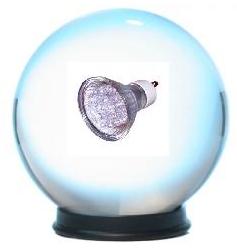
Lightfair, the world’s largest annual tradeshow and conference for lighting professionals, came to Philadelphia in early May, lighting up the Convention Center in a brilliant blaze of LEDs. Nearly every booth on the exhibit floor sprouted LED light bulbs in every conceivable size and shape. According to workshop leader Mark Lien, a lighting specialist with Osram Sylvania, we have just begun to discover the amazing capabilities of this technology. Here are some excerpts from his presentation:
• The Climate Group, a nonprofit organization advocating for clean energy, recently completed a study of 15 lighting projects in 12 cities. Results indicated that switching to LED street lights may have been responsible for as much as 85% of the energy savings.
• Entire industries are shifting to LED – Automotive News magazine, for example, is advising car dealerships that it’s time to go LED in their showrooms and lots.
• Leasing as alternative to buying LEDs – in some cases, lease payments are lower than energy savings, providing a positive cash flow from day one. And in three years, when the lease is up, there will be newer, better lights available.
• LLEDs can carry WIFI signals faster than anything else can – up to 130 megabits per second. The possibilities are endless. Think of walking into a store, typing the product you are seeking into your smart phone, and hitting “submit.” This sends signals to the LED lights in the store to locate the product and send that information back to your phone. The product then shows up on your phone as a dot on a map of the store. Soon, there will be an app for that.
• LED’s are having a positive impact on the grocery industry. Typically, 14% of a grocery store’s profit is lost by food expiring. However, red meat will last one day longer under LED lights because their lower wattages produce less heat. That translates to significant savings for a business that runs on narrow margins.
• LED impacts productivity in a wide range of areas. When the fluorescent overhead lights that are used to grow hydroponic plants are replaced by LED lights, the plants grow faster and better. Likewise, when LEDs are used in dairy production facilities, the cows produce 6% more milk. And in poultry production, LED lights produce chickens with less leg breakage, who reach their required weight earlier.
• Until now, manufacturers have been incorporating LED lights into traditionally designed fixtures instead of creating designs that take better advantage of the technology. Take the humble flashlight, for example. Since an LED light is typically composed of multiple diodes rather than one single bulb, these diodes can be spread out over a large flexible surface instead of being stuffed into one end of a tube. So instead of the narrow beam of light thrown by traditional flashlights, you could have a broad swath of light shining from a surface that can be folded, bent, or wrapped around another object. Time to think out of the box!
Posted April 25th, 2013 by GreenTech Energy Services

GreenTech staff attending Lightfair International in Philadelphia this week spent a few moments chatting with former Major League baseball pitcher Pedro Martínez at one of the 500 exhibitor booths covering the Pennsylvania Convention Center trade show floor.
Changes to the NJ Clean Energy Direct Install Program
Posted April 17th, 2013 by GreenTech Energy Services
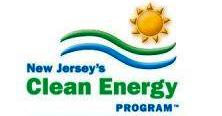 Direct Install makes it easy and affordable for owners of small to medium-sized commercial facilities in New Jersey to upgrade to high efficiency equipment. The program now pays up to 70% of the cost of replacing lighting, HVAC and other outdated operational equipment with energy efficient alternatives. Recently the incentive cap on each project was raised to $125,000, and eligibility was broadened to include facilities with a peak electric demand that did not exceed 200 kW in any of the preceding 12 months. Previously, the program capped projects at $75,000, was open only to buildings where peak demand did not exceed 150 kW, and only paid 60% of the costs. These changes will open the program up to many commercial and industrial buildings that were previously ineligible.
Direct Install makes it easy and affordable for owners of small to medium-sized commercial facilities in New Jersey to upgrade to high efficiency equipment. The program now pays up to 70% of the cost of replacing lighting, HVAC and other outdated operational equipment with energy efficient alternatives. Recently the incentive cap on each project was raised to $125,000, and eligibility was broadened to include facilities with a peak electric demand that did not exceed 200 kW in any of the preceding 12 months. Previously, the program capped projects at $75,000, was open only to buildings where peak demand did not exceed 150 kW, and only paid 60% of the costs. These changes will open the program up to many commercial and industrial buildings that were previously ineligible.
To participate, applicants must submit the last 12 months of electric utility bills indicating that they are below the demand threshold and have occupied the building during that time. Buildings must be located in New Jersey and served by one of the state’s public, regulated electric or natural gas utility companies. The equipment covered by this program includes lighting, heating, cooling & ventilation, refrigeration, motors, natural gas, and variable frequency drives.
BENEFITS
Turnkey Process – Selected participating contractors address a project from start to finish, beginning with an assessment of the facility, and ending with the installation of eligible energy-efficient equipment.
Minimal Cost – The owner’s share of the project’s cost will be approximately 30% and the program pays the remaining 70%, significantly shortening the payback.
Fast Turnaround Time – Project installations are typically completed within 90 days from the time of scheduling the energy assessment.
Ongoing Savings – New energy-efficient equipment will provide savings for years to come through dramatically reduced energy costs on monthly utility bills.
STEPS TO PARTICIPATION
The contractor schedules an energy assessment and works with customer to complete the program application and participation agreement.
After the energy assessment, the contractor reviews the results with the customer, including what measures qualify and the customer’s share of the project cost.
The customer signs a scope of work document to proceed with implementation of qualifying measures.
The customer and the participating contractor set a convenient start date for the installation.
Once the participating contractor completes the installation, the customer accepts the work by signing a project completion form.
The customer pays the participating contractor a portion of the project cost and New Jersey’s Clean Energy Program pays the rest.
Contact us today to see if your business qualifies for this program!
GreenTech Sales Team is Growing!
Posted April 3rd, 2013 by GreenTech Energy Services
 GreenTech welcomes two new additions to our sales team, Evan Levy (on left) and Dave Wright. Both account representatives bring to their positions extensive experience in lead generation for the energy industry. They will be responsible for developing leads and selling lighting retrofit projects in a variety of vertical markets, including commercial/industrial, property management, and education. Welcome aboard, guys!
GreenTech welcomes two new additions to our sales team, Evan Levy (on left) and Dave Wright. Both account representatives bring to their positions extensive experience in lead generation for the energy industry. They will be responsible for developing leads and selling lighting retrofit projects in a variety of vertical markets, including commercial/industrial, property management, and education. Welcome aboard, guys!
Jump-starting Energy Efficiency Projects in Commercial Real Estate
Posted March 19th, 2013 by GreenTech Energy Services
The commercial real estate market is still reeling from the effects of the recession. Capital expenditure and operating budgets have been slashed, putting energy projects on the back burner, especially those with long paybacks. Owners are more likely to set aside capital to meet the needs of their core business rather than to replace obsolete, energy-hungry lighting, HVAC and other technology. Connecticut is trying to address this dilemma with a program that provides easy access to financing for energy efficiency projects. The program, dubbed Connecticut Property Assessed Clean Energy (C-PACE), works like this:
- Enables property owners to access low-cost, long-term funding for qualified energy upgrades through a benefit assessment on their property
- Repayable through property taxes, collected by the municipality in the same way as other benefits assessments
- Assessment has priority over existing mortgages
- Owner must secure written consent from the mortgage holder prior to project approval.
Over a dozen municipalities throughout the state have opted into the program so far, and eight capital providers have been pre-approved to fund the projects. The financing can be used to cover all stages of a project, from audits and engineering to construction and verification of energy savings, and can be used for both large and small projects, single measures such as lighting, and projects with prior energy audits completed but not yet acted on. The many benefits of this type of financing include the following:
- Property tax payments may qualify as an operating expense
- Payments can be passed through to tenants who benefit from the energy savings
- Long-term financing allows energy savings to exceed the finance payments – and create positive cash flow – from day one.
- New energy efficient equipment increases a building’s value and ability to attract tenants
LED Lights take Center Stage in Auditoriums
Posted March 19th, 2013 by GreenTech Energy Services
As LED technology becomes more affordable, there are a growing number of ways it can be used to replace less energy efficient interior lighting. One of these applications is in auditoriums, such as the one in the Garnet Valley (Pennsylvania) Middle School, where GreenTech recently replaced 150- and 250-watt incandescent quartz lamps with 17- and 24-watt LED’s. The retrofit provided significant energy savings while eliminating shadows and enhancing aesthetics, as shown in the before-and-after photos below.
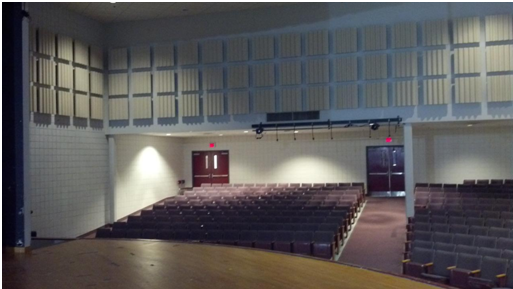 |
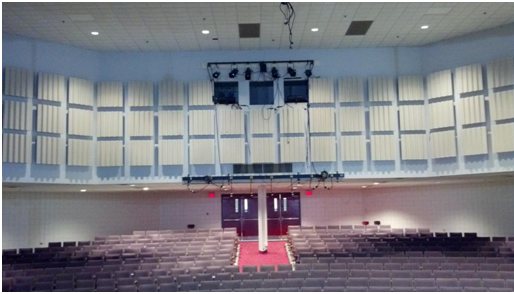 |
GreenTech Energy Services
email@greentechenergy.com
Phone: 856-439-9400
122 East Kings Highway, Ste 503
Maple Shade, NJ 08052
